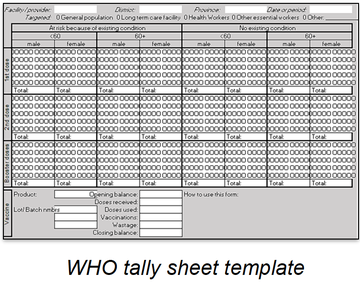Module 5
How to Participate
To participate in this training module, complete the following activities in the prescribed order:
- Complete the Pre-Test
- Read the training materials
- Complete the Post-Test

Learning Objective
At the end of this module, learners should be able to:
- explain the importance of proper recording and reporting;
- recognize recording and registration forms;
- correctly record vaccination data and register vaccinations in the reporting forms; and
- explain how to track defaulters (if applicable).
Why is Proper Reporting & Recording Important?
Reporting and recording is important because:
- For the individual vaccinated, they need a vaccination card, or a certificate, or proof of vaccination.
- To monitor progress with vaccine uptake and coverage,
- To help with vaccine and supply management.
- To inform vaccine effectiveness and vaccine safety through the COVID-19 surveillance and safety AEFI surveillance.
What type of records could be completed at the health facility level?
There are two types of records collected at the health facility, each explored in detail below:
- Home-Based Records These are personal or individual vaccination records. These vaccination cards or certificates are kept by the individual or the person who is vaccinated, and are needed to prove a vaccination, for example, in the case of travel, or employment, or education.
- Facility-Based Records include records kept at the facility and may include:
- Vaccine register
- Electronic Immunization Registry and/or medical record system (only for countries where available);
- Tally sheets (only for countries with aggregation based system); and
- Monthly/periodic reports (only for countries with aggregation based system).
Home-Based Vaccination Records
What Purposed to Home-Based Vaccination Records Serve?
- As proof of vaccination for individual’s travel, educational or occupational purposes
- To establish vaccination status in coverage surveys
- To provide vaccination information in case of AEFI or positive COVID 19 test
- To provide an immunization document for adults and older adults to which other vaccinations can be recorded, along with vaccination for COVID 19
- To monitor timing of subsequent vaccination dose (if required)
What will home-based vaccination records include?
Countries may choose slightly different templates for home-based vaccination records. It's important to refer to the instructions and standard operating procedures on how to use and fill out the national or even sub-national standards for that home-based record. In general, we know that the home-based records will include:
- Personal and contact information of the vaccine recipient
- Date for next dose (if applicable)
- One line for each dose and booster (if applicable). Each line will include:
- date of vaccination
- vaccine product
- dose number
- batch/lot number
- name of facility/provider/institution
- stamp/signature
Facility-Based Vaccination Records
What Purposed to Facility-Based Vaccination Records Serve?
Facility based records are kept in the facility, hospital, long term care facility, or doctor’s office. Broadly their purpose is the same as personal vaccination records, but they also serve to:
- enable providers to send reminders to patients For example to find people who received the first dose, but haven't come back yet on time for their second or third doses
- report data to public health authorities. For example, in case of an adverse event following immunization, you can find the batch number that you used for that patient and report it back as needed.
What will facility-based vaccination records include?
In addition to information available from the personal vaccination record, facility-based vaccination records will include:
- contact information of vaccinated person;
- important risk factors of vaccinated person; and
- any adverse events following immunization (AEFI)
Tools for Aggregation-Based Reporting
Tally Sheets
Tally sheets are forms to keep track of vaccinations administered by a vaccination provider or facility during an established period - Allows to tally by target group of interest (age, sex, pre existing condition, etc.) - Separate sheets can be used for sessions targeting specific groups such as health workers, schools, long term care facilities

Periodic Reports
Periodic reports are used to summarize administered vaccinations by dimension of disaggregation (age, sex, occupation, etc.) together with vaccines used and other relevant information. Periodic reports are often prepared as a paper report at the service delivery level, consolidated and digitized at the district level
How to Report Vaccinations
Fill out periodic reports (according to national/sub national frequency and timeliness standards)
Periodic reports should include:
- vaccinations administered to the target groups (as defined by your country);
- vaccine balances, vaccines used, vaccines spoilt, and wastage;
- adverse events following immunization (AEFI); and
- any other information required by your national/sub national reporting standards.
Tracking of Defaulters
Most COVID-19 vaccines will require several doses. Depending on the product that is used in your country, it might be two or three doses, and maybe also booster doses after that. It will become important to find in your facility- based registers or electronic systems to identify individuals who were immunized the first time, but didn't come back for immunization for the second dose or the third dose, also known as defaulters.
Defaulters can be contacted through SMS, phone calls or community volunteers to:
- remind the eligible target groups to get the vaccine; and
- follow up with individuals who were expected to receive a dose of COVID 19 vaccine but did not.
Additional Resources
- guidance reporting forms
- standard templates
- standard operating procedures
Average Rating: ☆ ☆ ☆ ☆ ☆ (0 reviews)




